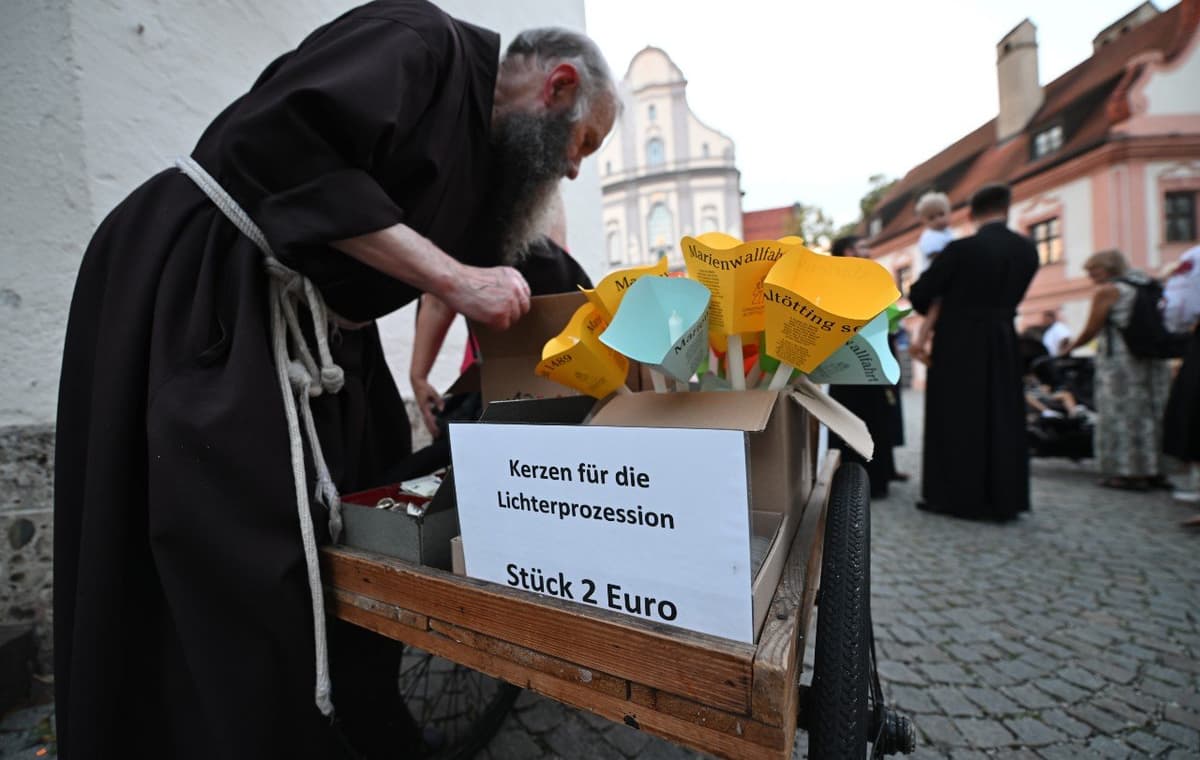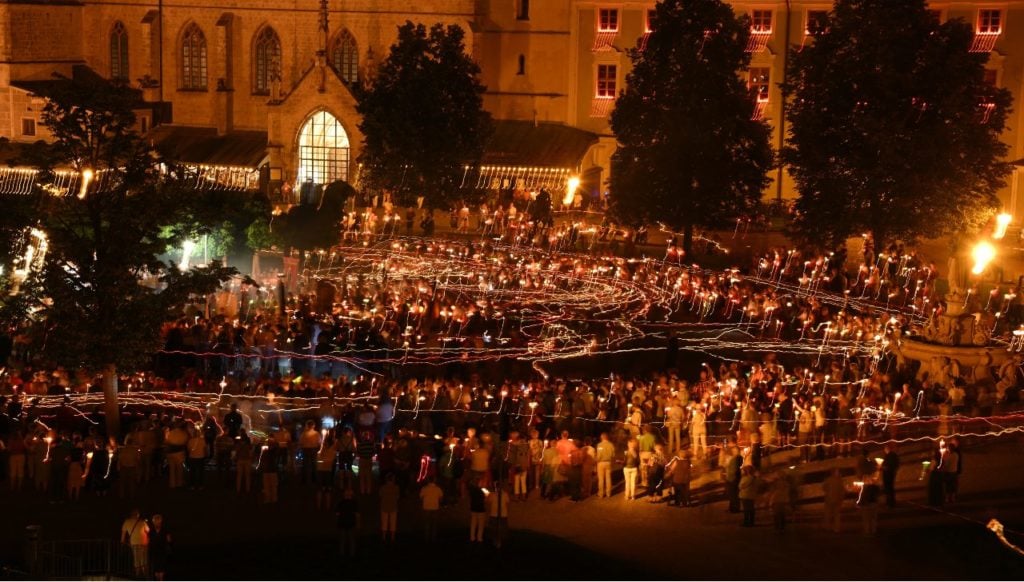Why August 15th is a public holiday in parts of Germany

It may feel like most of Germany is on holiday already - but residents of a few lucky German states get an extra day off work Tuesday. Here's why.
For most states in Germany, August is the last month of the school summer holidays and a time when many families choose to jet off somewhere sunny for a relaxing break.
But for those still at their office desks can look forward to a public holiday in the middle of the month - depending on which region they live in.
In Saarland and several parts of Bavaria, shops and businesses close their doors on August 15th to mark Mariä Himmelfahrt.
This is an important date in the Catholic Church's calendar - the Assumption of the Virgin, which commemorates the day the Virgin Mary entered heaven.
It has been a tradition for Christians to celebrate Mary's ascension into heaven since the 7th century, though this was only enshrined in dogma in the 1950s by Pope Pius XII. Since then, it has been a binding article of faith in the Catholic church.
Several other countries Europe that are primarily Catholic - including Spain, Croatia, Belgium and France - also celebrate the Assumption of Mary on August 15th.
In largely protestant Germany, however, Mariä Himmelfahrt is only a public holiday in the areas with large Catholic populations. That means that major cities in Bavaria such as Munich, Augsburg, Würzburg, Regensburg and Ingolstadt have the day off on August 15th, but Franconian cities like Nuremberg, Fürth and Erlangen do not.
With so many events in the Catholic calendar, the catholic districts of Bavaria have 13 public holidays - with Augsburg getting a bonus holiday known as the High Peace Festival, or Hohes Friedensfest, on August 8th.
READ ALSO: Why does the Bavarian city of Augsburg have its own public holiday?
This makes Bavaria the state with the most public holidays in Germany.
However, even in areas of Germany where people have to work, devout Catholics still mark August 15th with a festive church service. There is also a traditional light procession the night before, where churchgoers carry candles and sing hymns.
Since Mary plays a much less central role in protestant theology, Mariä Himmelfahrt isn't celebrated by in the Protestant church.
How Catholic is Germany?
Despite being largely surrounded by Catholic countries such as Austria, Switzerland and Poland, Germany is generally considered a Protestant - or Evangelisches - country.
This is largely because Germany was a major driving force in the Reformation: a movement that sought to challenge the corruption of the Catholic church and focus Christian beliefs on Biblical scripture rather than traditions.
The 16th-century reformer Martin Luther is the most famous of the thinkers of this time, and if you visit the Castle Church in Wittenberg, Saxony-Anhalt you can still see the door where he nailed his 95 theses attacking Catholic principles and instructions.

A traditional light procession at a chapel in Altötting, Bavaria, to celebrate Mariä Himmelfahrt. Photo: picture alliance/dpa | Angelika Warmuth
The Reformation ultimately led to a splitting of the Christian church into Catholicism and Protestantism, which can still be traced regionally in Germany.
The some 21.6 million Catholics are largely concentrated in the southern and western states and make up 26 percent of the population. In both Saarland and Bavaria, for example, 62 percent of the population are Catholic.
READ ALSO: Six things to know about Catholicism in Germany
There are slightly fewer Protestants in Germany - 19.7 million, making up 23.7 percent of the population - and they are largely found in the northern and central states.
In the eastern states that formerly made up the secular GDR, the majority of the population is unaffiliated to any church.
Is it Maria Himmelfahrt or Mariä Himmelfahrt?
Though you're likely to hear most Germans refer to the holiday as Maria Himmelfahrt, the correct name for the holiday is actually Mariä Himmelfahrt.
The unusual spelling is influenced by Latin, where the possessive (i.e. the Assumption of Mary) is conjugated by changing the ending of the noun.
For the same reason, the Assumption of Christ is referred to in German as Christi Himmelfahrt, with an 'i' at the end of Christ.
Comments
See Also
For most states in Germany, August is the last month of the school summer holidays and a time when many families choose to jet off somewhere sunny for a relaxing break.
But for those still at their office desks can look forward to a public holiday in the middle of the month - depending on which region they live in.
In Saarland and several parts of Bavaria, shops and businesses close their doors on August 15th to mark Mariä Himmelfahrt.
This is an important date in the Catholic Church's calendar - the Assumption of the Virgin, which commemorates the day the Virgin Mary entered heaven.
It has been a tradition for Christians to celebrate Mary's ascension into heaven since the 7th century, though this was only enshrined in dogma in the 1950s by Pope Pius XII. Since then, it has been a binding article of faith in the Catholic church.
Several other countries Europe that are primarily Catholic - including Spain, Croatia, Belgium and France - also celebrate the Assumption of Mary on August 15th.
In largely protestant Germany, however, Mariä Himmelfahrt is only a public holiday in the areas with large Catholic populations. That means that major cities in Bavaria such as Munich, Augsburg, Würzburg, Regensburg and Ingolstadt have the day off on August 15th, but Franconian cities like Nuremberg, Fürth and Erlangen do not.
With so many events in the Catholic calendar, the catholic districts of Bavaria have 13 public holidays - with Augsburg getting a bonus holiday known as the High Peace Festival, or Hohes Friedensfest, on August 8th.
READ ALSO: Why does the Bavarian city of Augsburg have its own public holiday?
This makes Bavaria the state with the most public holidays in Germany.
However, even in areas of Germany where people have to work, devout Catholics still mark August 15th with a festive church service. There is also a traditional light procession the night before, where churchgoers carry candles and sing hymns.
Since Mary plays a much less central role in protestant theology, Mariä Himmelfahrt isn't celebrated by in the Protestant church.
How Catholic is Germany?
Despite being largely surrounded by Catholic countries such as Austria, Switzerland and Poland, Germany is generally considered a Protestant - or Evangelisches - country.
This is largely because Germany was a major driving force in the Reformation: a movement that sought to challenge the corruption of the Catholic church and focus Christian beliefs on Biblical scripture rather than traditions.
The 16th-century reformer Martin Luther is the most famous of the thinkers of this time, and if you visit the Castle Church in Wittenberg, Saxony-Anhalt you can still see the door where he nailed his 95 theses attacking Catholic principles and instructions.

The Reformation ultimately led to a splitting of the Christian church into Catholicism and Protestantism, which can still be traced regionally in Germany.
The some 21.6 million Catholics are largely concentrated in the southern and western states and make up 26 percent of the population. In both Saarland and Bavaria, for example, 62 percent of the population are Catholic.
READ ALSO: Six things to know about Catholicism in Germany
There are slightly fewer Protestants in Germany - 19.7 million, making up 23.7 percent of the population - and they are largely found in the northern and central states.
In the eastern states that formerly made up the secular GDR, the majority of the population is unaffiliated to any church.
Is it Maria Himmelfahrt or Mariä Himmelfahrt?
Though you're likely to hear most Germans refer to the holiday as Maria Himmelfahrt, the correct name for the holiday is actually Mariä Himmelfahrt.
The unusual spelling is influenced by Latin, where the possessive (i.e. the Assumption of Mary) is conjugated by changing the ending of the noun.
For the same reason, the Assumption of Christ is referred to in German as Christi Himmelfahrt, with an 'i' at the end of Christ.
Join the conversation in our comments section below. Share your own views and experience and if you have a question or suggestion for our journalists then email us at [email protected].
Please keep comments civil, constructive and on topic – and make sure to read our terms of use before getting involved.
Please log in here to leave a comment.